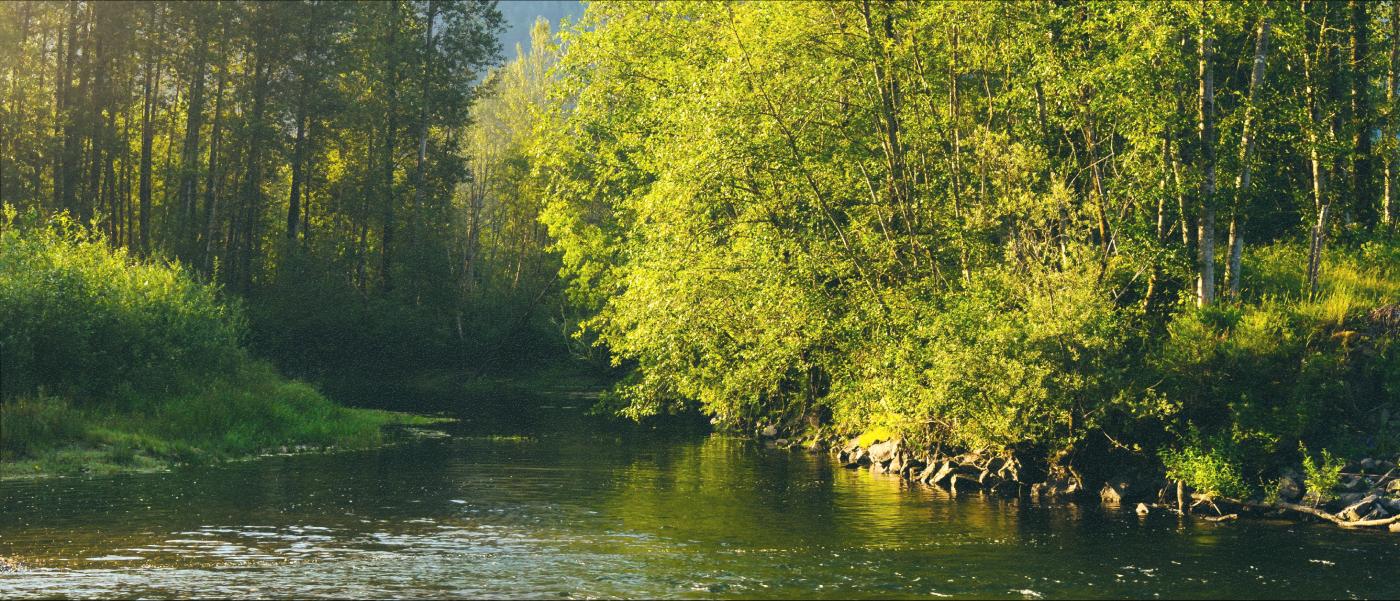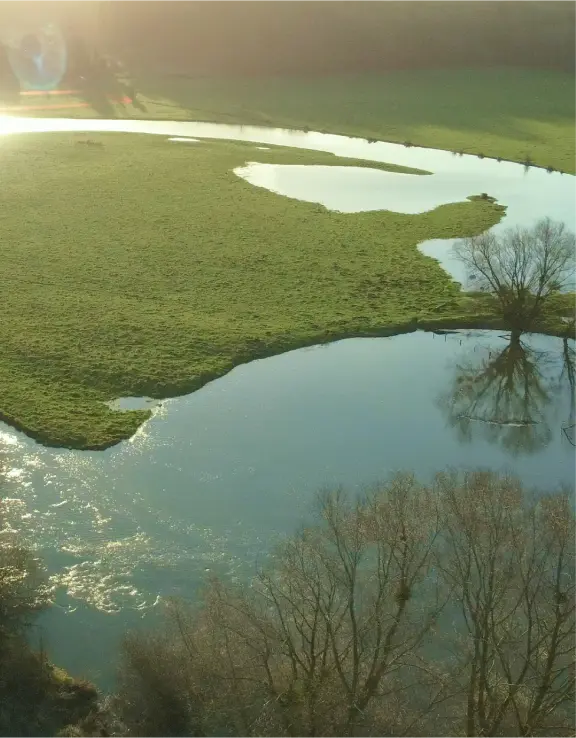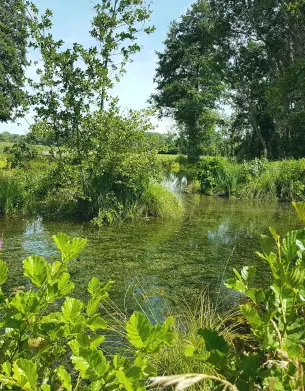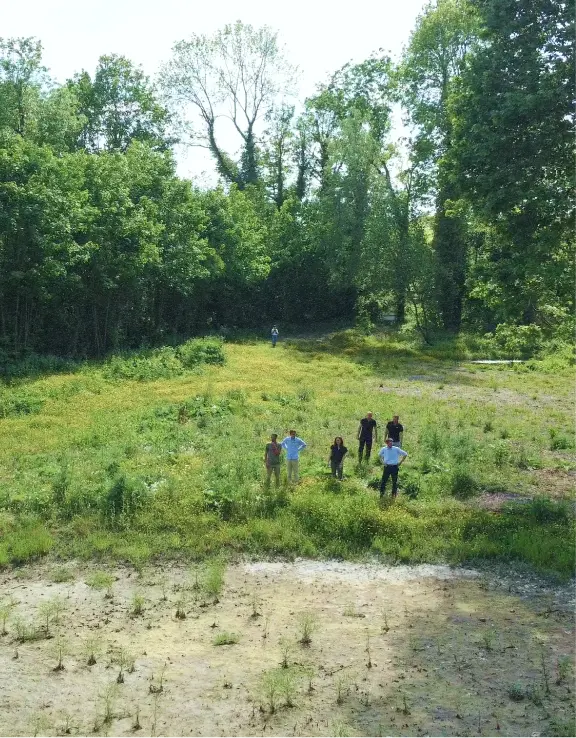
Osmaïa innovates and operates in France and all over Europe through its different brands. For 130 years, its 1,700 employees have been empowering nature, putting it at the heart of our every day for everyone’s well-being.


It helps us meet the challenge of recovering damaged ecosystems. Our aim is to empower nature so it can restake its claim.
We restore the habitat of animals and plants so they can live and reproduce there. The end game is also to encourage many natural essentials: water purification, pollination, climate regulation, air purification, carbon sinks, natural cycles, food, wood, materials, etc. – all things that life on this planet depends upon.
For ten years, Osmaïa has been building specialised teams for ecological engineering projects. These projects require keen observation skills and demand specific expertise.
01
Implement ecological compensation after the avoidance and reduction phases.
02
Restoration of aquatic habitats
Restoration of rivers and wetlands within the framework of the European Water Directive.
03
Managing natural spaces: ENS, Natura 2000, parks, nature reserves, etc.
04
For companies, local authorities and private customers, volunteer operations for ecological restoration.
For our teams, ecological engineering marks a new state of mind, a genuine commitment to nature.
This motivation is clearly evident at Osmaïa: one of our partners has earned the highest eco-engineering qualification (Kalisterre) and six Osmaïa companies are now members of the Professional Union for Ecological Engineering. For everyone in the group, this means biodiversity is fully integrated into all of our activities and operations.

Parc Astérix - Plailly (60)
Restoration of lawn on sand, felling a stand of pine trees and removal of a layer of humus
Ecological compensation - Trosly-Breuil (60)
Opening up a brownfield site to restore a wetland area
Regional Park of Vexin Français - Haute-Isle (95)
Reopening of chalky grasslands with hand-clearing and winching
It is sometimes necessary to open up woodland to create a mosaic of habitats that stimulate biodiversity.
This encourages habitat diversification, allowing different strata of vegetation to express themselves in one place: herbaceous stratum in meadows and brownfield areas, shrub stratum at tiered edges and tree stratum for the woodland. This work helps:
Soils are a precious natural resource. They are complex living environments subject to many pressures (urbanisation, erosion, intensive farming, compaction, depletion and more).
They support life and provide many essential elements.
Some ecological engineering operations aim to restore soils and their function which may have been damaged (fertility, carbon sinks, water storage, fauna shelter).
We work on the soil to encourage the development of plant species and seed banks. We can also strip away the top surface rich in humus to expose the seminal milieu necessary to express the diversity of the species present.
Sandy heath in Oise - Plailly (60)
Restoration of heathland on sand - animal and vegetation clearing to respect the soils
Grand Paris Express - Draveil (91)
Restoration of the mesophilic grassland environment on an old landfill - felling, rehabilitation of the soils and seeding.
Expanding flood areas in La Beuvronne - Claye-Souilly (77)
Stripping away the top soil layers to relaunch the site’s hydraulic function
Expanding flood areas in La Beuvronne - La Bassée à La Tombe (77)
Stripping away the top soil layers to relaunch the site’s hydraulic function
Vulcania - Saint Ours (63)
Natural grassland reproduction by brushing wild grasslands
Compensatory measures SGP - La Grande-Paroisse (77)
Natural grassland reproduction by brushing wild grasslands
Wild grassland is a particularly rich environment where a wide range of plants (up to 150 species) and animals co-exist.
This relationship needs conservation at a local scale because grasslands serve as a habitat and source of food for many insects.
For several years, the Osmaïa Group has been interested in restoring or creating wild grasslands using methods that preserve the genetic legacy of heritage grassland.
We use green hay transfer and brushing to collect seeds from a grassland site.
Green and blue belts define all of the ecological networks and biodiversity reservoirs.
These corridors allow species to travel and provide habitats and food for many species. The mix of populations in these corridors is essential to ensure the genetic cross-breeding and sustainability of populations.
To develop and strengthen ecological continuity and facilitate species mobility:
Rail bypass of industrial sites - Donges (44)
On-site compensation and creation of eco-corridors to restore continuity
Landscaping Base 217 - Brétigny-sur-Orge (91)
Restoration of ecological continuity by transplantation, local species planting and seeding natural grasslands
Le Port aux Cerises - Draveil (91)
Restoration of the stream, riparian woodland and defences
Arc de Dierrey - Troyes (10)
Restoration of the ecological functions of watercourses by protecting the banks, building fascines and installing flow diversion groynes.
Le Bédat - Cébazat (63)
Restoration of flow and hydraulic functionalities of the River Bédat with particle refill, building willow fascines and aquatic plants.
Cours d’eau de la Mayenne - La Jaille-Yvon (49)
Restoration of ecological continuity by removing weirs, particle refill and planting the riparian woodland.
Human activities have subjected many watercourses to extensive changes: creation of weirs, channelling, straightening and more.
These restrictive alterations prevent the watercourse from evolving naturally and considerably reduce its functions.
We work on river banks, the river beds and the riparian woodland to restore the natural qualities which guarantee diverse species and habitats.
Creating natural light, using plant engineering techniques, securing the woodland, managing log jams, restoring fish populations, re-meandering, particle refill and diversification of flows are all operations that we provide to bring a watercourse back to life.
Home to many plant species and a great variety of animal species too, wetlands play a decisive role in the quality of water and its regulation.
They are also where amphibians and a great many birds live, reproduce and pass through. The remarkable flora in wetlands adds to this diversity.
The restoration of these environments is at the heart of our business. We use all our expertise to ensure damaged wetlands rediscover their former functions (levelling pools and banks, clearing/filling, transplanting and planting).
Canal Seine Nord Europe - Compiègne (60)
Restoration and improvement of the function of wetlands by excavating, managing invasive species, creating ponds and oxbow lakes, planting
Pilot site in La Bassée - Châtenay-sur-Seine (77)
Reconstitution of a mosaic of habitats typical of the Seine Valley by opening environments, levelling, creating pools, creating habitats and planting
Carandeau weir - Choisy-au-Bac (60)
Restoration of wetlands and their function with forest work, levelling, ponds and planting
Compensatory measures SGP - Draveil (91)
Reconstitution of the habitats of the little ringed plover and the small blue-tailed damselfly by opening the area, levelling, soil provision, seeding and planting
Parc Astérix - Plailly (60)
Creation of specific habitats for reptiles and hymenoptera
We can create a wide range of artificial habitats to alleviate habitat destruction and preserve and encourage the return of specific animal species.
Thanks to a specific site’s resources and material repurposing, we create wood piles, winter shelters, dry stone walls, brushwood fences, waste heaps and set up nesting boxes – all places and spaces that animals can take over.
These artificial habitats are complementary to ecological landscaping and provide animals the right conditions to express their biological diversity.
It is often necessary to fence our sites to defend and ensure the safety of delicate environments, protected species or ecological landscaping.
These man-made structures have one aim: to protect biodiversity and reduce any damage to the ecosystems.
Amphibians are protected from destruction either permanently or temporarily by specific fences that restrict them to a given area. These fences avoid any interaction between machines and protected species during the construction phase and along the roads to reduce the risks of collisions with vehicles.
To reduce the negative impact of habitat fragmentation, caused by infrastructure networks in particular, we also help create and restore animal corridors, encouraging ecological connections between two natural areas or pools of biodiversity.
Restriction and protection - Plailly (60)
Barrier installation to protect amphibians
Constellium - Biesheim (68)
Compensatory measures for restoring meso-hygrophile environments by installing marker nets, amphibian barriers, grid fences
Landscaping Base 217 - Brétigny-sur-Orge (91)
Ecological restoration by creating underground animal passages
Lit majeur de l’Oise - Chiry-Ourscamp (60)
Management of the lance-leaved aster by uprooting and removal, seeding and plantings for diversification
La Bourde - Epône (78)
Eradication of Japanese knotweed by excavation, removal and inversion of the layers with rhizome sorting
Port aux Cerises - Draveil (91)
Opening up of a thicket of sycamore trees and fighting the site’s jimsonweed colonisation by uprooting, removal and sowing wild seeds
Invasive alien plant species are the fifth largest cause of biodiversity erosion.
They cause significant dysfunction in ecosystems and reduce biodiversity as they represent powerful competition for native species. Their strong presence smothers natural environments and weakens biodiversity.
As they are becoming increasingly present particularly in degraded soils, we need to know and recognise these species to adapt our management methods.
Armed with many proven techniques (uprooting, girdling, felling, stripping away contaminated soils, covering, sifting, etc.), we adapt our work to each specific case to achieve the best possible results on these alien invaders and leave the native species to express themselves freely.
Local and native plants naturally represent a specific genetic diversity adapted to an area’s soils, climate and fauna.
This makes the plants particularly resistant to diseases and pathogens, water stress and large variations in temperature.
We have always been interested in these wild plants and today we can offer our customers local and native nurseries for all their projects.
We take care of the entire process, from harvesting the seed in the natural environment to digging up the plant for replanting elsewhere. The young plants are managed as naturally as possible without selection, so they grow to be hardy with the resilience typical of wild plants.
The local nurseries also host various educational events for local residents, rooting these unique production sites in the local community.
Local nursery - Ivry-sur-Seine (94)
A local nursery to ensure plant availability for future local projects.
Wild plant nursery - Chanteloup-en-Brie (77)
A local nursery for native wild plants to ensure plant availability and the right diversity for future local projects.
Landscaping Base 217 - Brétigny-sur-Orge (91)
Seeding, transplanting and planting of local plants to supply future projects at Base 217
Leisure park - Draveil (91)
Ecological maintenance of compensatory measures by cutting, pruning and managing invasive species
Société du Grand Paris
Multi-site ecological management of compensatory measures for a long-term management plan: opening environments, edging, wooded environments and wetlands
La Bassée - Châtenay-sur-Seine (77)
Maintenance of wetlands by removal of dead wood and log jams
If there are no major changes, natural environments in our temperate regions have a tendency to close in on themselves through colonisation and the development of woody vegetation.
Historically, large herbivores played a key role in keeping environments open. Today, we need to intervene to preserve the diversity of the environments and the plants and animals that live there and pass through.
On our customers’ sites, we implement the right management methods to respect these environments.
These techniques include pastureland conversion, late cutting and gathering (grassland), clearing (edging), felling and pruning (woodland) and cutting or digging up plants in aquatic environments.
Any questions?
We’ll be pleased to help.